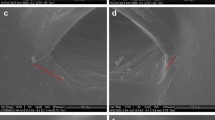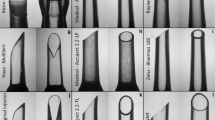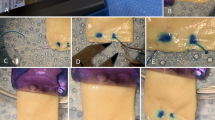Abstract ·
Background: Previous studies have demonstrated that incision sizes required for insertion of various foldable intraocular lenses (IOLs) vary according to the IOL/inserter combination. The purpose of this study was to compare incision sizes and wound shape for both forceps and injector implantation of high-refractive-index silicone IOLs. · Methods: In fresh human cadaver eyes, limbal corneal tunnel incisions were created, and 12 foldable high-refractive-index silicone (dimethyldiphenylsiloxane) IOLs were inserted in a randomized fashion using either a forceps or an injector. Using incision calipers, internal and external measurements of the tunnel incisions were obtained before and after IOL insertion. Scanning electron microscopy (SEM) was performed on selected corneas following IOL insertion. Additionally, in 12 cataract procedures, the incision sizes following forceps or injector implantation were evaluated intraoperatively. · Results: In the experimental setting, the external and internal tunnel widths (in mm) before insertion were 3.05 mm (±0.07) and 3.02 mm (±0.03), respectively, with the forceps and 3.06 mm (±0.04) and 3.01 mm (±0.04) with the injector. Following IOL implantation, the external and internal incision sizes were 3.33 mm (±0.07) and 3.33 mm (±0.04) with the forceps and 3.32 mm (±0.08) and 3.33 mm (±0.07) with the injector. SEM showed tearing of corneal structures after implantation through the smallest possible incisions with both devices. In the clinical study, the incision sizes before and after implantation were 3.23 mm (±0.10) and 3.36 mm (±0.06) with the forceps and 3.11 mm (±0.08) and 3.21 mm (±0.10) with the injector. · Conclusions: This study confirms that high-refractive-index silicone IOLs provide one of the smallest currently achievable incisions before and after IOL implantation. In clinical use, the new injector reduces the mean incision size required by approximately 0.1 mm.
Similar content being viewed by others
Author information
Authors and Affiliations
Additional information
Received: 27 February 1998 Revised version received: 28 April 1998 Accepted: 29 April 1998
Rights and permissions
About this article
Cite this article
Kohnen, T., Koch, D. Experimental and clinical evaluation of incision size and shape following forceps and injector implantation of a three-piece high-refractive-index silicone intraocular lens. Graefe's Arch Clin Exp Ophthalmol 236, 922–928 (1998). https://doi.org/10.1007/s004170050181
Issue Date:
DOI: https://doi.org/10.1007/s004170050181




